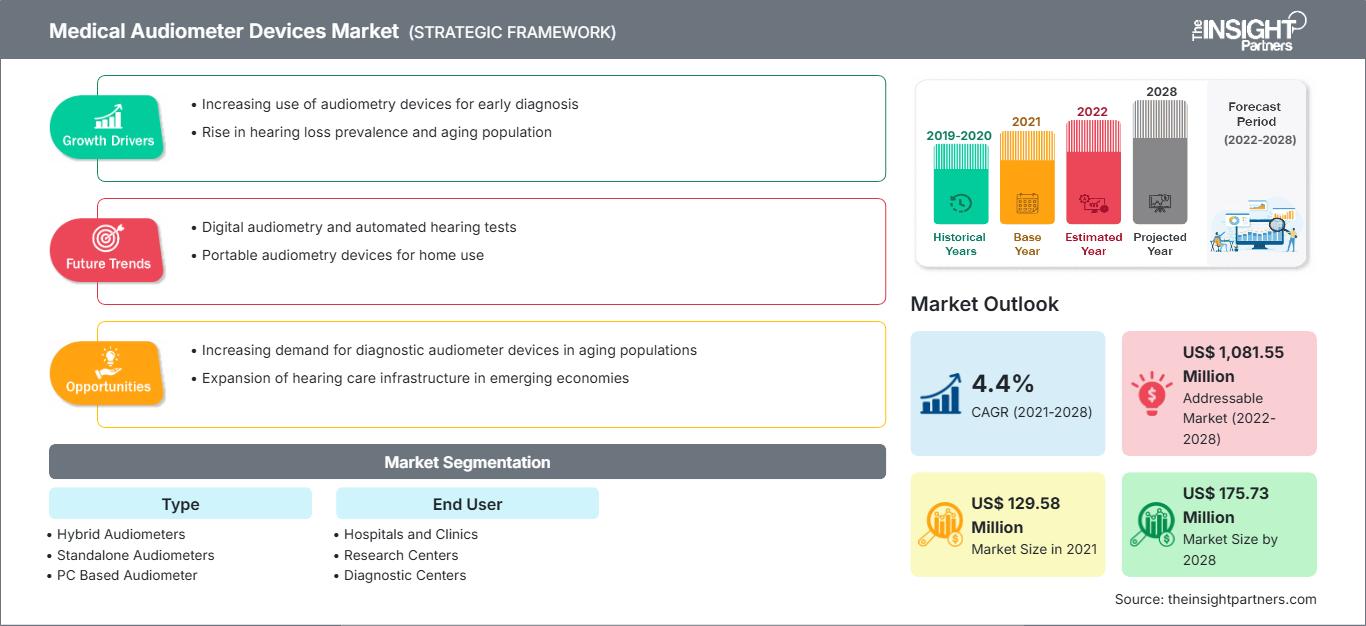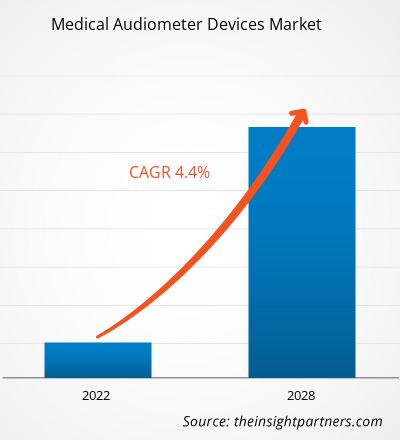Le marché des audiomètres médicaux devrait atteindre 175,73 millions de dollars américains d'ici 2028, contre 129,58 millions de dollars américains en 2021 ; sa croissance devrait atteindre un TCAC de 4,4 % entre 2021 et 2028.
Les audiomètres médicaux sont des appareils utilisés pour évaluer le niveau d'audition et mesurer et diagnostiquer la gravité de la perte auditive. Les audiomètres sont constitués d'un matériel intégré et d'un bouton de rétroaction pour le participant, connecté à un casque. Un PC classique est utilisé pour contrôler ce système. L'audiométrie est une technique permettant de déterminer la capacité auditive d'une personne. Les types de procédures audiométriques comprennent l'audiométrie d'immittance, l'audiométrie tonale pure, l'audiométrie à réponse évoquée et l'audiométrie vocale. Diverses avancées technologiques ont conduit au développement d'audiomètres hybrides et d'audiomètres sur PC pour communiquer et améliorer la qualité de vie.
Le marché des audiomètres médicaux a été segmenté en fonction du type, de l'utilisateur final et de la géographie. Géographiquement, le marché est principalement segmenté en Amérique du Nord, Europe, Asie-Pacifique, Moyen-Orient et Afrique, et Amérique du Sud et centrale. Le rapport offre des informations et une analyse approfondie du marché des audiomètres médicaux, en mettant l'accent sur les tendances du marché, les avancées technologiques, la dynamique du marché et l'analyse de la concurrence des principaux acteurs mondiaux.
Vous bénéficierez d’une personnalisation sur n’importe quel rapport - gratuitement - y compris des parties de ce rapport, ou une analyse au niveau du pays, un pack de données Excel, ainsi que de profiter d’offres exceptionnelles et de réductions pour les start-ups et les universités
Marché des audiomètres médicaux: Perspectives stratégiques

-
Obtenez les principales tendances clés du marché de ce rapport.Cet échantillon GRATUIT comprendra une analyse de données, allant des tendances du marché aux estimations et prévisions.
Aperçu du marché
Prévalence croissante des troubles auditifs
La prévalence des troubles auditifs augmente partout dans le monde. Les troubles auditifs peuvent entraîner une déficience auditive supérieure à 40 décibels (dB) dans l'oreille la mieux entendue chez l'adulte et supérieure à 30 dB dans l'oreille la mieux entendue chez l'enfant. Les troubles auditifs peuvent être une incapacité héréditaire ou congénitale, ou être causés par une maladie infectieuse, une infection chronique de l'oreille, une exposition à un bruit excessif et la vieillesse. Les infections infantiles telles que la rougeole, les oreillons et la méningite, l'exposition à un bruit excessif ou prolongé et l'otite moyenne chronique sont également responsables de déficience auditive. La perte auditive est devenue la maladie la plus courante chez les patients, en particulier dans les pays industrialisés. Selon l'Organisation mondiale de la santé (OMS), environ 5 % de la population mondiale souffre d'une déficience auditive. Le nombre de personnes vivant avec cette condition médicale devrait dépasser les 900 millions d'ici 2050. De même, selon la Hearing Industries Association, plus de 4,22 millions d'appareils auditifs ont été distribués aux États-Unis en 2019, soit une augmentation de 6,5 % par rapport au nombre signalé en 2018.
Selon le rapport de la Hearing Loss Association of America (HLAA), Hearing Loss Facts and Statistics 2018, environ 48 millions d'Américains souffrent d'une certaine perte auditive. Il mentionne également que 2 à 3 enfants sur 1 000 aux États-Unis naissent avec un niveau détectable de perte auditive dans une ou les deux oreilles. Selon les données rapportées par les Centers for Disease Control and Prevention, environ 16 % des adultes aux États-Unis déclarent avoir des problèmes d'audition, et 1 homme sur 5 et 1 femme sur 8 ont déclaré avoir une forme de problème d'audition. La prévalence de la perte auditive est deux fois plus fréquente que celle du diabète ou du cancer. Environ 11 % des Américains signalent des acouphènes ou des bourdonnements d'oreilles.
Ainsi, la prévalence croissante des troubles auditifs et de la perte auditive au sein de la population stimule les ventes d'audiomètres médicaux.
Informations basées sur le type
Le marché des audiomètres médicaux est segmenté en fonction du type : audiomètres hybrides, audiomètres autonomes et audiomètres sur PC. Le segment des audiomètres sur PC représenterait la plus grande part de marché en 2021, et le segment des audiomètres hybrides devrait enregistrer le TCAC le plus élevé au cours de la période de prévision.
Informations basées sur l'utilisateur final
Le marché des audiomètres médicaux est segmenté en fonction de l'utilisateur final : hôpitaux et cliniques, centres de recherche et centres de diagnostic. Le segment des hôpitaux et des cliniques devrait détenir la plus grande part de marché en 2021, et devrait enregistrer le TCAC le plus élevé du marché au cours de la période de prévision.
La pandémie de COVID-19 est devenue le défi le plus important au monde. Face à la pression exercée sur les systèmes de santé du monde entier, il était essentiel de prioriser les ressources limitées afin de minimiser les admissions à l'hôpital. Cependant, les acteurs du marché ont adopté une approche innovante en matière de solutions de télé-audiologie pour prendre en charge les patients malentendants. Par exemple, Satellite Tele-Audiology Solutions, filiale d'Inventis, est considérée comme la première technologie de ce type. Cette technologie permet aux audiologistes d'interagir et de réaliser à distance des évaluations auditives complètes avec leurs patients en temps réel. Ces développements par les principaux acteurs du marché ont permis de minimiser l'impact de la pandémie de COVID-19 sur le marché des audiomètres médicaux.
Les acquisitions, les collaborations, les partenariats, les lancements de produits et les expansions sont des stratégies courantes adoptées par les entreprises pour étendre leur présence mondiale et répondre à la demande croissante. Les acteurs du marché des appareils audiométriques médicaux ont principalement adopté la stratégie d'innovation de produits pour répondre à l'évolution de la demande des clients à travers le monde, ce qui les aide également à maintenir leur nom de marque à l'échelle mondiale.
Aperçu régional du marché des audiomètres médicaux
Les tendances régionales et les facteurs influençant le marché des audiomètres médicaux tout au long de la période de prévision ont été analysés en détail par les analystes de The Insight Partners. Cette section aborde également les segments de marché et la géographie du marché des audiomètres médicaux en Amérique du Nord, en Europe, en Asie-Pacifique, au Moyen-Orient et en Afrique, ainsi qu'en Amérique du Sud et en Amérique centrale.
Portée du rapport sur le marché des audiomètres médicaux
| Attribut de rapport | Détails |
|---|---|
| Taille du marché en 2021 | US$ 129.58 Million |
| Taille du marché par 2028 | US$ 175.73 Million |
| TCAC mondial (2021 - 2028) | 4.4% |
| Données historiques | 2019-2020 |
| Période de prévision | 2022-2028 |
| Segments couverts |
By Type
|
| Régions et pays couverts |
Amérique du Nord
|
| Leaders du marché et profils d'entreprises clés |
|
Densité des acteurs du marché des audiomètres médicaux : comprendre son impact sur la dynamique commerciale
Le marché des audiomètres médicaux connaît une croissance rapide, porté par une demande croissante des utilisateurs finaux, due à des facteurs tels que l'évolution des préférences des consommateurs, les avancées technologiques et une meilleure connaissance des avantages du produit. Face à cette demande croissante, les entreprises élargissent leur offre, innovent pour répondre aux besoins des consommateurs et capitalisent sur les nouvelles tendances, ce qui alimente la croissance du marché.

- Obtenez le Marché des audiomètres médicaux Aperçu des principaux acteurs clés
- Analyse historique (2 ans), année de base, prévision (7 ans) avec TCAC
- Analyse PEST et SWOT
- Taille du marché Valeur / Volume - Mondial, Régional, Pays
- Industrie et paysage concurrentiel
- Ensemble de données Excel
Rapports récents
Rapports connexes
Témoignages
Raison d'acheter
- Prise de décision éclairée
- Compréhension de la dynamique du marché
- Analyse concurrentielle
- Connaissances clients
- Prévisions de marché
- Atténuation des risques
- Planification stratégique
- Justification des investissements
- Identification des marchés émergents
- Amélioration des stratégies marketing
- Amélioration de l'efficacité opérationnelle
- Alignement sur les tendances réglementaires






















 Obtenez un échantillon gratuit pour - Marché des audiomètres médicaux
Obtenez un échantillon gratuit pour - Marché des audiomètres médicaux